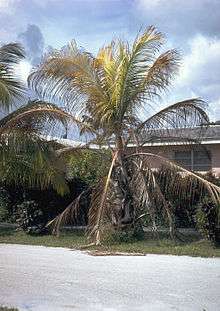Lethal yellowing
| Lethal yellowing | |
|---|---|
 Palm tree dying of lethal yellowing | |
| Common names | Coconut lethal yellowing phytoplasma |
| Causal agents | Phytoplasma sp |
| Hosts | Arecaceae (palms) |
| Vectors | planthoppers (Haplaxius crudus) |
| EPPO code | PHYP56 |
| Distribution | Florida, parts of the Caribbean and Central America, East Africa |
Lethal Yellowing is a phytoplasma disease that attacks many species of palms, including some commercially important species such as the coconut and date palm. In Caribbean It is spread by the planthopper Haplaxius crudus (former name Myndus crudus) which is native to Florida, parts of the Caribbean and Central America.[1] The only effective cure is prevention, i.e. planting resistant varieties of coconut palm and preventing a park or 'golf course like' environments which attracts the planthopper. Some cultivars, such as the Jamaica Tall coconut cultivar nearly died out by lethal yellowing. Heavy turf grasses and similar green ground cover will attract the planthopper to lay its eggs and the nymphs develop at the roots of these grasses. The planthoppers eggs and nymphs may pose a great threat to coconut growing countries' economies, into which grass seeds for golf courses and lawns are imported from the Americas. It is not clearly understood how the disease was spread to East Africa as the planthopper Haplaxius crudus is not native in East Africa
The only explanation is that it was imported with grass seed from Florida that were used to create golf courses and lawns in beach resorts. There is a direct connection between green lawns and the spread of lethal yellowing in Florida. Even so-called 'resistant cultivars' such as the Malayan Dwarf or the Maypan hybrid between that dwarf and the Panama Tall were never claimed to have a 100% immunity.The nymphs of the planthoppers develop on roots of grasses, hence the areas of grass in the vicinity of palm trees is connected with the spread of this phytoplasma disease. The problem arose as a direct result of using coconut and date palms for ornamental and landscaping purposes in lawns, golf courses and gardens together with these grasses. When these two important food palms were grown in traditional ways (without grasses) in plantations and along the shores, the palm groves weren't noticeably affected by lethal yellowing. There is no evidence that disease can be spread when instruments used to cut an infected palm are then used to cut or trim a healthy one. Seed transmission has never been demonstrated, although the phytoplasma can be found in coconut seednuts, but phytosanitary quarantine procedures that prevent movement of coconut seed, seedlings and mature palms out of an LY epidemic area should be applied to grasses and other plants that may be carrying infected vectors.
Beside coconut palm (Cocus nucifera), more than 30 palm species have also been reported as susceptible to lethal phytoplasmas around the globe.[2] In Mozambique coconut lethal yellowing has recently been associated with African oil palm (Elaeis guineensis) and fan palm (Borassus aethiopum).[3]
See also
References
- ↑ Brown, S.E., Been, B.O. & McLaughlin, W.A. (2006). Detection and variability of the lethal yellowing group (16Sr IV) phytoplasmas in the Cedusa sp. (Hemiptera: Auchenorrhyncha: Derbidae) in Jamaica. Annals of Applied Biology, 149(1), pp. 53–62
- ↑ Howard, F. (1992). Lethal yellowing susceptibility of date palms in Florida. Principes, 36(4), pp. 217–222
- ↑ Bila, J., Högberg, N., Mondjana, A. & Samils, B. (2015). African fan palm (Borassus aethiopum) and oil palm (Elaeis guineensis) are alternate hosts of coconut lethal yellowing phytoplasma in Mozambique. African Journal of Biotechnology, 14(52), pp. 3359–3367. DOI: 10.5897/AJB2015.15002
- EPPO quarantine data sheet: Palm lethal yellowing (pdf file)
- Lethal Yellowing of Palm
- Lethal Yellowing of Palm Trees in Florida